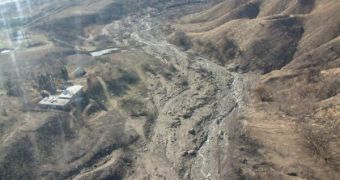According to a new scientific study, it may be that air tides, or atmospheric-pressure fluctuations, are capable of causing massive landslides. The investigation that led to this conclusion was conducted on the Slumgullion landslide, a landscape feature located in the San Juan Mountains of southwestern Colorado, and that has been going downhill for about 700 years. The rocks inside move to the base of the mountain at an average speed of about one millimeter every two hours, but they seem to be going even faster at night. This is very peculiar, Nature News reports.
Geology books tell us that such long-lasting slides usually flow faster during the day, and then reduce their speed at nighttime, due to the fact that the water that may be making it easier for the rocks to slide on top of each other freezes. But the Slumgullion is weird because its flow accelerates during the spring snow melt, but also during the night. These mysterious movements captured the attention of expert William Schulz and his team, all from the United States Geological Survey (USGS).
They monitored the site for about two months, installing measurement equipment at two locations on the landslide. The team monitored the water pressure inside pores in the soil, external weather conditions, as well as the speed of the slide, hourly. They determined that the variations in flow speed were directly correlated to the “atmospheric tides.” This is the name experts give to daily atmospheric highs and lows in air pressure. These phenomena are created by the shifting influence of the Sun's rays, and also by the Moon's gravitational pull.
In a new scientific paper detailing the finds, published in the latest issue of the respected journal Nature Geoscience, the USGS experts wrote that the Slumgullion landslide seemed to be traveling faster during the night, when its flow picked up speed, and slower or not at all during the day. The best explanation the team has is that the air variations change the properties of the friction forces that hold the landslide in check, whichever they may be.
Speaking of the new study, University of Karlsruhe landslide expert Falk Lindenmaier said that, while “we do know that heavy rainfall is the most common trigger mechanism [for landslide], (...) this must not lead us to ignore other processes at play.”

 14 DAY TRIAL //
14 DAY TRIAL //